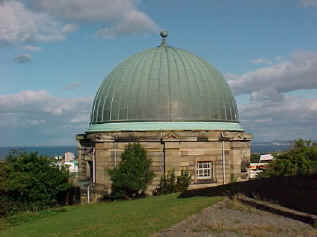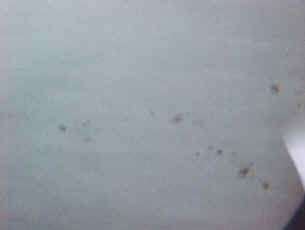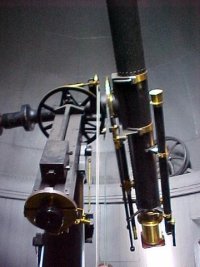British Astronomical Association: Aurora Section
N.B. This is a purely personal and limited account of the days' proceedings.
Saturday 8th September 2001, Dr. Russell Cockman and myself, Malcolm Gibb, travelled to Edinburgh for the annual meeting of the British Astronomical Association Aurora Section. This was hosted by the Astronomical Society of Edinburgh at their meeting place in the City Observatory on Calton Hill. Lorna McCalman President of AS of Edinburgh welcomed the delegates, about forty in all and introduced the chairman for the morning session, Dr. David Gavine, Assistant Director of the BAA aurora Section.

The city observatory, Calton Hill
The first talk of the day was by Ron Livesey, Director of the BAA Aurora Section and was entitled 'What happens to your aurora observations'. He explained how a report should be reported! The date, time, observers name, where observing from are important then the condition of the aurora, i.e. is it quiet or active, rays or bands, pulsing or flickering and so on, each condition having a code. Then the structure, was it homogeneous, striated, short, medium or long rays again with codes. The auroral form, was it glows, arcs rays, bands, veils or undefined. The brightness and colour are also recorded, each with a code. The elevation from the base to the top and the direction using compass bearings should also be recorded and if possible a sketch.
The section has observers who are members of the BAA and other astronomical societies, individual observers, meteorologists and there used to be ships' officers at sea but they have dropped in number over the last few years. Perhaps North Sea oil platforms could be a new source of reports? The original reports are recorded and placed in the archives of Aberdeen University. The details of them are the subject of annual reports published in the BAA Journal. There is a specialist magnetometery group within the section which measures the earth's magnetic field related to auroral activity. A most interesting and entertaining talk.
Dr. Michael Gadsden then took over and his talk was 'Noctilucent Clouds - Everywhere'. The BAA aurora section also observes noctilucent clouds hence the reason for this talk. He started by explaining what NCLs were, how they formed and how to observe and report them. The clouds occur in the mesosphere at a height of about 83 km where the temperature is between -130' and -160' and the barometric pressure is only a few millionths of the sea-level pressure. There are very small amounts of water vapour present at that height and under these conditions ice crystals grow and form thin tenuous clouds, NCLs.
As with the aurora, there is a reporting system within the BAA (to Dr. David Gavine) and these observations are collected along with the rest of the European observations. All the records since 1964 onwards are held by Aberdeen University, compiled by Dr. Gadsden and published as an annual survey in the Meteorological Magazine. In his address, Dr Gadsden gave several theories as to how NCLs may have appeared. Is more methane or carbon dioxide in the atmosphere responsible? More methane would give more water into the mesosphere which in turn should mean more and brighter noctilucent clouds but although there has been a slow increase in sightings the clouds have not got brighter, so global warming may not be the source. NCLs need water to form, some could come from extraterrestrial comet-rain storming the Earth, water in the troposphere can soar to the mesosphere. These and other theories fascinated the audience and more information on this subject can be found clicking here.

Sun spots
The next talk was to have been by Neil Grubb and entitled 'CCD of the Sun, Aurora, NCL' but unfortunately Neil was on call and could not attend. Instead a slide show of aurora images by Jim Henderson was given. Jim is a professional photographer from Aberdeenshire and a number of the photographs were taken with a fish-eye lens giving a whole sky view, which is something even your eyes can't see, resulting in some stunning images.
During the lunch break, some of us took the opportunity to have a look round the Playfair building and especially the Cooke 6" refractor. Naturally, as it was daylight with some clear patches of sky the telescope was turned to the Sun and solar projection. The only flat white material to hand, was a piece of A4 paper but that was enough and the resulting image is shown here. Only about a quarter of the Sun is shown in this photograph which was taken with a Sony Mavica FD75 digital camera, but it shows a lovely group of sunspots. Below it is the 6" Cooke refractor telescope.
After lunch, Ron Livesey took over as chairman and introduced Dr. Alistair Simmons whose talk was entitled 'Arctic Aurorae'. Dr. Simmons is President of the Scottish Astronomers Group and a member of the Council of the Astronomical Society of Glasgow. Over quite a number of years Dr. Simmons has spent two or three weeks each winter in the high Arctic studying the arctic aurorae. He has based himself in Tromso in Norway and in the Canadian Arctic and been extremely lucky in the times he has chosen and has seen and photographed some amazing aurora. His talk, illustrated with many excellent slides, was both entertaining and instructive, we even learned what one should do when confronted by a grizzly bear or a polar bear! (Don't run, stand up, put your hands in the air and make yourself look as big as possible.)

6" Cooke refractor telescope
Dr. David Gavine was next and his talk was entitled 'Monastic Records of the Aurora'. I found this a fascinating subject even more so when we found that Dr Gavine had learned medieval Latin so that he could translate the manuscripts from that time. The descriptions in the records were simply what the people of that age believed they saw in the sky, charging horsemen, pillars of fire and great swordfights in the sky, with a bit of imagination I suppose we could see them in aurora today. The contemporary drawings showed all these and more and one had to imagine what really went on in the minds of the people who saw these 'pictures' in the sky. Were they foretelling future events or pictures of past battles? A fascinating subject, presented in a most entertaining style and one to think about the next time you see the Northern Lights, let your imagination run free!
After a break for tea or coffee the meeting was opened to any other contributions from the speakers or audience members. Mike (I'm sorry, I can't remember the surname or where he came from, if you read this Mike, please let me know) showed some slides of noctilucent clouds taken recently and Dr. Russell Cockman from AFA showed some of his aurora images with a couple of my own slides of noctilucent clouds taken on 4th August this year. All were well received by the audience.
The meeting ended with an informal get together of the delegates in the Playfair building and the hospitality of the A. S. of Edinburgh was again in evidence.
| Agenda | |
|---|---|
| Dr. David Gavine, Assistant Director, BAA Aurora section is chairman for the morning session | |
| 10.30-10.35 | Welcome by Mrs. Lorna McCalman, President of the Astronomical Society of Edinburgh. |
| 10.35-11.05 | Ron Livesey : 'What happens to your aurora observations?' |
| 11.05-12.00 | Dr. Michael Gadsden : ' Noctilucent Clouds - Everywhere?' |
| 12.00-12.30 | Dr. Neil Grubb sent his apologies. A slide presentation of aurora by Jim Henderson was shown instead. |
| 12.30-14.00 | Lunch. |
| Ron Livesey, Director, BAA Aurora Section is chairman for the afternoon session | |
| 14.00-15.00 | Dr. Alistair Simmons : 'Artic Aurora' |
| 15.00-15.30 | Dr. David Gavine : 'Monastic Records of the Aurora' |
| 15.30-15.50 | Tea and coffee break. |
| 15.50-16.30 | Any other contributions from speakers or audience members. |